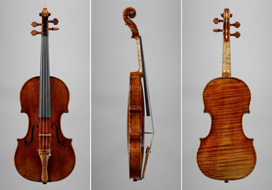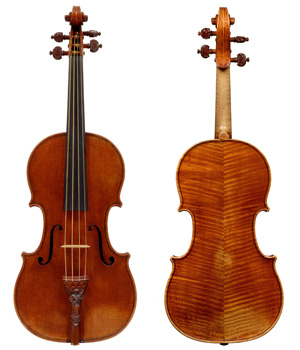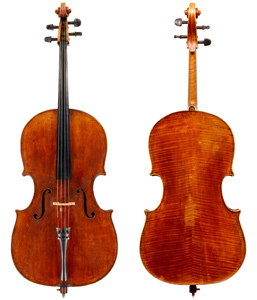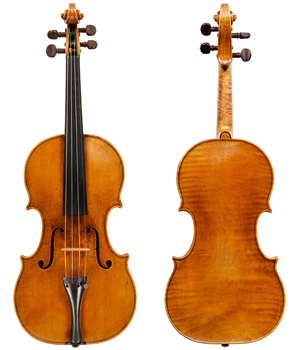
Dmitry Gindin: Expert and consultant in fine stringed instruments
A guide to the market for the finest instruments and their values (2021)Until recently, legendary instruments were linked to the musicians who owned them. The last few decades have witnessed a shift, as most of the greatest instruments not in permanent institutional collections or museums no longer belong to performers. Even the best-paid classical musicians today can no longer afford them due to an escalation of their value. The fine-instrument trade has become an investment-based market, subject to supply and demand as in other branches of rare art, with one important paradoxical difference: most fine and rare instruments still find use as indispensable tools in concert performance, rather than spending their life sealed away in bank vaults. They are indispensable in the work of musicians, making their artistic value and investment potential secondary to their primary purpose of making music. The long upward trend in the investor market for the finest instruments, with its various nuances and a strong preference for the greatest examples, shows no sign of abating. APPRAISINGAppraisers are those most connected to the market itself - the dealers, specialised auctioneers and, in some cases, experts. Their evaluations are usually based on a combination of their own and other past sale results of similar items. However, their job is complicated in that no two identical instruments or bows exist to allow for exact comparison. Prices for rare items can fluctuate from example to example even within works by the same maker, and may also depend on the purpose of the appraisal: is it for insurance 'replacement value', for a quick sale through a third party to a dealer or a musician, or for a commission sale through an auction or dealership? Retail prices can vary across continents and within individual countries; currency fluctuations and the type of venue executing a sale also affect pricing. Apart from published public auction results, most transactions are private, so that little more than a value range can be estimated for a given instrument at a given time. Criteria used for appraising include authenticity and period of production (if known), condition, level of workmanship, provenance, model, sound quality, varnish colour and fashion. Perceived or actual authenticity of all parts, as well as the state of preservation, remain amongst the most important criteria in evaluation and are generally viewed as relatively objective. But only a small percentage of old instruments conform to the category of 'fine, original, characteristic and in excellent condition'. Thus a good start for appraising may be to set a range of retail value for a very fine example (if known), and then to deduct certain percentages for any deviations from the 'gold standards' of undisputed authenticity and excellent condition. VALUING MULTIMILLION-DOLLAR INSTRUMENTS It is well known that the finest, centuries-old instruments are now valued in the millions of dollars. Yet only a handful of maker's names are consistently associated with ultra-high values: Antonio Stradivari and his sons, Francesco and Omobono; Giuseppe Guarneri del Gesù; and Carlo Bergonzi. Today's increasingly heated market for these names suggests that the apex of Cremona's golden age lingered over the final, roughly 40 years of its 200-year history; far higher prices are consistently achieved for their finest examples from their respective prized years than for instruments in similar condition from their other working periods. The most discerning connoisseurs seem to associate Stradivari's best work with a so-called 'golden period' of ca. 1707-1718. The term should be applied with caution in appraisals, as many exceptional examples exist from outside this period. It has been tempting, financially and otherwise, to prolong Stradivari's most valuable working period to include as many of his works as possible, with some dealers and connoisseurs suggesting broader time frames, such as 1700-1725.  Considerably younger than Stradivari, Bergonzi and Guarneri del Gesù began working for their own accounts about half a century after Stradivari; during most of Stradivari's arguably best years, their work is non-existent, little known, or described as 'early', and thus not nearly as well considered as their later output. In the meantime, their own best production coincides and overlaps; it is generally accepted that Bergonzi's best work comes from ca. 1732-1740 and that of Guarneri del Gesù from ca. 1735-1744. Bergonzi's violin-making career, spanning over 30 years, has posed particular polemics, since not much more than a quarter of his 50 to 60 extant instruments retain their original labels, making them difficult to date. Most of del Gesù's labels, too, are difficult to authenticate, though due to his extant instruments being several times more plentiful than Bergonzi's, his are more easily classifiable into working periods.  Guarneri violins seem to currently hold price records among stringed instruments, with several examples valued well above $20 million. Two superb examples at the higher end of the range include the 1742 'Lord Wilton' and his exceptional 'Vieuxtemps' violin of ca. 1741, which realised a price of $16 million in 2012. Bergonzi's work, though it has already escalated in value since the retrospective held in Cremona in 2010, will likely always remain in third place, with asking prices for his violins thus far not exceeding $4.5 million, to my knowledge. However, I expect his very finest works - similar in quality to many instruments by his two rivals - to move higher against them in the near future. The last time the 1721 'Lady Blunt' Stradivari violin was sold, it fetched £9.8 million ($15.9 million at the time), then a record for any instrument. It was made during the upper end of the 'golden period'; other, similar violins from the same period exist, though their value does not approach this level, due mainly to the Blunt's extraordinary freshness, colourful history and particularly beautifully glowing varnish. Its most recent sale price - again a world record - was almost 116 times greater than the £84,500 ($200,000) paid for it in 1971 at Sotheby's. Due to sterling's long decline against the dollar, the violin appreciated 80-fold when expressed in USD - still a massively improved performance over the Dow Jones, which over the same 40 years rose some 14-fold, though one cannot compare the liquidity of the New York Stock Exchange with that of a stringed instrument. I do not mean to suggest that Stradivari's other output, or that of less important makers, has seen such levels of appreciation. On the whole, however, the available data confirm their long-term investment performance. Bargain-hunters, if we may call them that, may still pick up a 'Strad' or 'del Gesù' for a few million dollars. These will doubtless come with serious issues, including non-authentic parts; but even these instruments are rare and many may prefer to invest in a great Giovanni Battista Guadagnini, usually with smaller financial outlay. Valuing Guadagnini's work is challenging, as his style changed significantly depending on the towns where he worked. While nearly all his instruments boast superb sound, it is his late Turin violins, most influenced by the late Stradivari model, that have historically been judged to be of greatest value, at times bringing close to double the price of his equivalent works from earlier times. This may change in time, with the prices of some of his earlier models, such as those of his Milan period, approaching, or in a few cases surpassing, some of the Turin instruments. Guadagnini's violins and his several violas of good size will almost certainly achieve world records in the coming years. Other makers' work, in particular cellos and violas of exceptional quality, also attract well over a million dollars, due to their scarcity. In this price category are the violins, violas and cellos of most of the Guarneris as well as the 'grand pattern' Amatis. Somewhere in this category are now also the finer works of Michelangelo Bergonzi, son of Carlo, and the extremely rare violas and cellos by his nephew, Nicola. Cellos by Domenico Montagnana, Matteo Goffriller, Francesco Ruggeri, the two Rogeris, David Teccher, and Carlo Tononi can also easily cross the million-dollar threshold. More occasionally, the fine and rare cellos by the first two generations of the Gaglianos, the very finest of which are amongst the fastest-rising in the market, have also recently joined this elite group.  The cellos of Montagnana, Goffriller, Tononi, Tecchler and his pupil, Michael Platner, may command well over triple the prices of their violins. While Montagnana's and Goffriller's violins are not usually valued as highly as most of those by Guadganini, they may occasionally qualify as fine solo instruments. Most of their cellos, however, in particular those by Montagnana, are of supreme quality and have been played by the greatest of artists, who have often preferred their lush, powerful tone even to those of Stradivari; Montagnana's best cellos may therefore command prices that begin to approach or, in some cases, surpass some by Stradivari. Violas are in a world of their own, and some of the makers cited above either never made them, or did so only very rarely. Those that do exist, when of desirable size, can achieve disproportionately high prices relative to their violin counterparts, in particular those of the greatest Brescian and Cremonese schools of the late-16th and 17th centuries, as well as those by Goffriller - not to mention the few of Stradivari, should they ever come on the market.  Grand Pattern Nicolo Amati Violin from 1682 Instruments of the Amatis are particularly difficult to value. Those by the patriarch, Andrea, are too few and for the most part permanently held in public and private collections. The sons of Andrea, Antonio and Girolamo, made instruments for about 40 years, though they are mostly the work of Girolamo and occasionally his more famous son, Nicolò. They are rare, often in compromised condition and of small size, and are therefore moderate in price. However, should a fine grand-pattern example, or a viola in relatively pure condition, come onto the market, its value would be comparable to that of instruments by Nicolò, whose best and largest violins are priced in the millions. The work of his son, Girolamo II, is only now becoming highly regarded, as connoisseurs begin to recognise and admire his hand in some of the greatest late instruments of his father. This contemporary of Antonio Stradivari sadly made few instruments following his father's death, yet some of his largest grand-pattern violins and his cellos are very similar in quality to the finest works of his father. Other, more easily found works, either in less-fresh condition or of lesser pedigree, fall into a category whose investment potential depends on many factors both objective and subjective, not least of which is playability. Such instruments, also hunted down consistently by institutions and wealthy investors, are also bound to appreciate, given the time, albeit at lower rates than the few highly sought-after names. The extreme price differential between the finest examples and 'basement bargains' also commonly exists among lesser instruments. Genuine instruments by the best makers, whether classical or more modern, make excellent long-term investments with relatively low risk, provided they are in fine condition. In many cases, they also serve great musicians and the music-loving public. Investors and sponsors of accomplished players often use them for promotion and publicity. Though relatively small, the international market for fine instruments has been gaining steam in recent years, in all categories, though especially at the high end. I believe in its continued longevity. |

|
